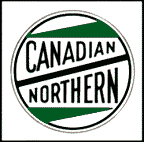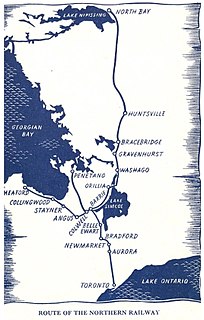
The Grand Trunk Railway was a railway system that operated in the Canadian provinces of Quebec and Ontario and in the American states of Connecticut, Maine, Michigan, Massachusetts, New Hampshire, and Vermont. The railway was operated from headquarters in Montreal, Quebec, with corporate headquarters in London, England. It cost an estimated $160 million to build. The Grand Trunk, its subsidiaries, and the Canadian Government Railways were precursors of today's Canadian National Railways.

The Canadian Northern Railway (CNoR) was a historic Canadian transcontinental railway. At its 1923 merger into the Canadian National Railway, the CNoR owned a main line between Quebec City and Vancouver via Ottawa, Winnipeg, and Edmonton.

Sir James David Edgar, was a Canadian politician.

The Algoma Central Railway is a railway in Northern Ontario that operates between Sault Ste. Marie and Hearst. It used to have a branch line to Wawa, Ontario. The area served by the railway is sparsely populated, with few roads.
The Ontario and Quebec Railway (O&Q) was a historic railway located in southern and eastern Ontario, Canada. It was initially chartered in March 1881 by managers of the Canadian Pacific Railway to run between Toronto and Perth, where it would connect, via a short branch line, to the CPR-controlled Brockville and Ottawa Railway. Construction began in 1882, and the line was completed in August 1884.

The International Railway of Maine was a historic railroad constructed by the Canadian Pacific Railway (CPR) between Lac-Mégantic, Quebec, and Mattawamkeag, Maine, closing a key gap in the railway's transcontinental main line to the port of Saint John, New Brunswick.

The Northern Railway of Canada was a railway in the province of Ontario, Canada. It was the first steam railway to enter service in what was then known as Upper Canada. It was eventually acquired by the Grand Trunk Railway, and is therefore a predecessor to the modern Canadian National Railway (CNR). Several sections of the line are still used by CNR and GO Transit.

The New York and Ottawa Railway was a railway connecting Tupper Lake in northeastern New York to Ottawa, Ontario, via Ramsayville Russell, Embrun, Finch and Cornwall. It became part of the New York Central Railroad system in 1913 although it was under the larger company's possession since the end of 1904. It had started out as the Northern Adirondack Railroad and evolved into the Northern New York Railroad, the New York and Ottawa Railroad and was last known as the New York and Ottawa Railway before being merged into the New York Central and Hudson River Railroad. Other lines that were a part of this route are described below.
The Midland Railway of Canada was a historical Canadian railway which ran from Port Hope, Ontario to Midland on Georgian Bay. The line was originally intended to run to Peterborough, but the competing Cobourg and Peterborough Railway was completed in 1854 and the owner's plans changed. Redirecting the line northward, it opened as the Port Hope, Lindsay & Beaverton Railway, a much longer line than originally planned. A further expansion launched in 1869 pushed the line westward towards Georgian Bay, and prompted renaming as the Midland Railway.

The Canada Southern Railway, also known as CSR, was a railway in southwestern Ontario, Canada, founded on February 28, 1868 as the Erie and Niagara Extension Railway. Its name was changed to Canada Southern Railway on December 24, 1869. The 1868 Act specified that it was to be constructed at a broad gauge of 5 ft 6 in, but that requirement was repealed in the 1869 Act, thus allowing construction at the standard gauge of 4 ft 8 1⁄2 in.

The Nosbonsing and Nipissing Railway (N&N) was a portage railway constructed by Ottawa lumber baron John Rudolphus Booth. The 5.5 miles (8.9 km) line connected Lake Nipissing with Lake Nosbonsing to allow lumber to be portaged onto the Mattawa River, and from there to the Ottawa River. It allowed timber from a wide area across central Ontario to be sent to Booth's mill in Ottawa, at that time the largest sawmill in the world.

The Parry Sound Colonization Railway Company (PSCR) is a historic Canadian railway that operated in Ontario. It originally intended to connect the town of Parry Sound to the Northern and Pacific Junction Railway but ran out of funds shortly after starting construction. The line was purchased by John Rudolphus Booth in 1892 to form the western end of his Ottawa, Arnprior and Parry Sound Railway. Failing to come to an agreement on the location of an associated port, the line ultimately bypassed the town completely, running to Depot Harbour, a company town.
The Ottawa, Arnprior and Parry Sound Railway, or OA&PS, is a historic railway that operated in central and eastern Ontario, Canada from 1897 until 1959. It was, for a time, the busiest railway route in Canada, carrying both timber and wood products from today's Algonquin Provincial Park areas, as well as up to 40% of the grain traffic from the Canadian west from Depot Harbour at Parry Sound through to the St. Lawrence River valley.
The Northern and Pacific Junction Railway (N&PJ) is a historic railway located in northern Ontario, Canada. It connected the Northern Railway of Canada's endpoint in Gravenhurst to the Canadian Pacific Railway (CPR) at Nipissing Junction, near North Bay. The N&PJ provided an almost straight line north-south route from Toronto to the transcontinental line, competing with a similar line of the Canadian Northern Railway (CNoR) a short distance to the east.
The Guelph Junction Railway is a shortline railway that is owned by the City of Guelph, Ontario, and serves the city's northwest industrial park.

The Toronto and Nipissing Railway, T&N, was the first public narrow-gauge railway in North America. It chartered in 1868 to build from Toronto to Lake Nipissing in Ontario, Canada, via York, Ontario, and Victoria Counties. At Nipissing it would meet the transcontinental lines of the Canadian Pacific Railway, providing a valuable link to Toronto. It opened in 1871, with service between Scarborough and Uxbridge. By December 1872 it was extended to Coboconk, but financial difficulties led to plans of the line being built further abandoned at this point. The railway merged with the Midland Railway of Canada in 1882.

The Credit Valley Railway was a railway located in Ontario, Canada from Toronto to St. Thomas. Chartered in 1871 by Ontario railway magnate George Laidlaw, it operated as an independent company until 1883 when it was leased by the Ontario and Quebec Railway, a Canadian Pacific Railway (CPR) operating company building a network of lines in southern Ontario.
The Lindsay, Bobcaygeon & Pontypool Railway (LB&P) was a short line railway in Ontario, Canada. It was originally designed to serve sawmills in Bobcaygeon, running southward to the Ontario and Quebec Railway at Burketon, near Pontypool. Passenger service for weekender trips to the beaches on Sturgeon Lake was a major service later in the line's life.
The Georgian Bay and Seaboard Railway (GB&S) was a former short-line railway in Ontario, Canada, owned and operated by Canadian Pacific Railway (CPR). The first sections opened in 1908, and the entire 140 kilometres (87 mi) route was fully completed in 1912.
The Irondale, Bancroft and Ottawa Railway (IB&O) was a short line railway in Central Ontario, Canada. The line was originally opened in 1878 as the Myles Branch Tramway, a horse-drawn wagonway connecting the Snowdon Iron Mine to the Victoria Railway a few miles away. The line was taken over by a group looking to build a northern extension of the Toronto and Nipissing Railway (T&N) as the Toronto and Nipissing Eastern Extension Railway. This extension was never built; instead, the company rechartered as the IB&O and used the Tramway as the basis for a new line with the ultimate aim to connect Orillia to the Ottawa area.











